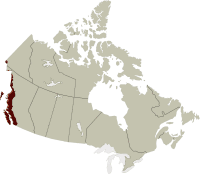 Pacific Maritime Ecozone Pacific Maritime Ecozone
Changing Forest Landscape Conditions
Healthy high-elevation forests: High-elevation forests, dominated by mountain hemlock and subalpine fir, cover approximately 4 million ha within the ecozone. These forests are considered healthy.
Coastal Douglas-fir forests: Coastal Douglas-fir
forests originally covered approximately 200 000 ha. Today, approximately
140 000 ha of forest remain, the rest having been converted to urban
or agricultural uses. This forest is predominantly younger than
100 years old due to a combination of harvesting and fires. These
forests continue to be converted to non-forest uses predominantly
for urban and agricultural pursuits (MacKinnon and Eng 1995).
Coastal temperate rainforest and harvesting: This
ecozone contains 25% of the remaining coastal temperate rainforest
worldwide (MacKinnon and Eng 1995). The vast majority of
regenerating and young forests result from logging, as stand-destroying,
natural disturbances are very uncommon in this ecozone. Area estimates
show that approximately 24% of this forest, within British Columbia,
has been logged and reforested; an additional 3% of the total area
has been logged and urbanized (MacKinnon and Eng 1995).
Logging is a major land-use activity within the ecozone, covering
approximately 50 000 ha annually (British
Columbia Ministry of Forests 1994; Environment
Canada 1995). Overall, more than 55% of trees in the remaining
rainforest, which is dominated by western hemlock and western red
cedar, are more than 250 years old (MacKinnon and Eng 1995).
Garbutt
and Allen
(1998) indicate that forest management practices, such
as species conversion, may be causing changes in insect and disease
dynamics that differ from those associated with the original coastal
forest. Some earlier research (Tkacz and Hansen 1982) has
indicated that, in areas where Douglas-fir has been widely planted
to replace western hemlock, a slower growing species, the incidence
of Phellinus
root disease has increased. This increase is attributable to
the resultant `pure' stands of Douglas-fir, which have less spatial
and age diversity than the original stands dominated by western
hemlock.

Changing Biodiversity
Old growth: The loss, through harvest, of the old growth of the coastal temperate rainforest is of public concern. Once harvested, the ecological dynamics and structure of these forests may be permanently altered as the regenerating forest will likely be harvested before an old-growth ecosystem is attained.
Recently, previously unknown invertebrate species, unique to the
canopies of coastal old-growth forests of this ecozone, have been
identified (Humble et al. 1997). Many wildlife species,
including birds such as the spotted-owl and the marbled murrelet,
rely on old-growth coastal forests (Cannings 1994). As
the area of old growth is reduced, wildlife habitat and other ecological
values and functions that these ecosystems provide are also reduced
(Clayoquot Sound Scientific Panel 1995).
Garry oak - Arbutus ecosystem: This ecosystem
is one of the rarest forest ecosystems in British Columbia and does
not occur elsewhere in Canada (British
Columbia Ministry of Environment, Lands and Parks 1993).
In British Columbia, it is restricted to the southeast coast of
Vancouver Island and the southern Gulf Islands. During the last
150 years, agricultural and urban development severely reduced its
extent. The decline has been particularly dramatic in the last three
decades. Fire suppression has allowed invasion by Douglas-fir. Overgrazing
by livestock and the eastern cottontail rabbit, an introduced species,
has created conditions for the establishment of many non-native
plant species. European
gypsy moth and Scotch
broom, both non-native species introduced through human activity,
are also continuing threats to native species. Considerable public
effort is underway to plant Garry oak and to protect the existing
tree population (British Columbia Ministry of Environment, Lands
and Parks 1993).
Changing Atmospheric Environment
Smog episodes - a concern? : Forests in the southwestern
portion of this ecozone are exposed to damaging concentrations of
tropospheric
(ground-level) ozone or smog originating from industrial and
urban activity associated with the Lower Mainland of British Columbia
(Dann and Summers 1997). The Lower Mainland is, in fact,
one of three areas within Canada that regularly experience episodic
events of ground-level ozone pollution at levels injurious to both
human and plant health. Ozone-like damage symptoms have been reported
on western white pines. Direct short-term effects on native species
would not be expected at measured ozone levels (Pearson and
Percy 1997). Repeated exposure over several seasons, however,
can lead to cumulative growth effects or predisposition to other
stressors of forest health (Runeckles and Wright 1996).
|